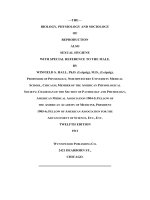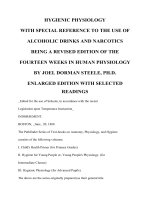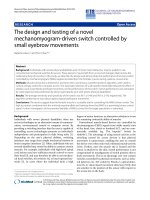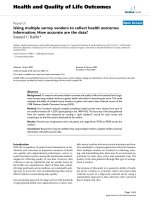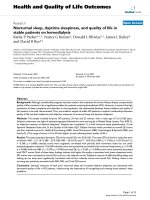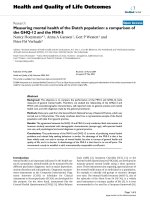THE BIOLOGY, PHYSIOLOGY AND SOCIOLOGY OF REPRODUCTION ALSO SEXUAL HYGIENE WITH SPECIAL REFERENCE TO THE MALE docx
Bạn đang xem bản rút gọn của tài liệu. Xem và tải ngay bản đầy đủ của tài liệu tại đây (444.53 KB, 100 trang )
—THE—
BIOLOGY, PHYSIOLOGY AND SOCIOLOGY
OF
REPRODUCTION
ALSO
SEXUAL HYGIENE
WITH SPECIAL REFERENCE TO THE MALE.
BY
WINFIELD S. HALL, Ph.D. (Leipzig), M.D., (Leipzig),
PROFESSOR OF PHYSIOLOGY, NORTHWESTERN UNIVERSITY MEDICAL
SCHOOL, CHICAGO; MEMBER OF THE AMERICAN PHYSIOLOGICAL
SOCIETY; CHAIRMAN OF THE SECTION OF PATHOLOGY AND PHYSIOLOGY,
AMERICAN MEDICAL ASSOCIATION 1904-5; FELLOW OF
THE AMERICAN ACADEMY OF MEDICINE, PRESIDENT
1905-6; FELLOW OF AMERICAN ASSOCIATION FOR THE
ADVANCEMENT OF SCIENCE, ETC., ETC.
TWELFTH EDITION
1911
WYNNEWOOD PUBLISHING CO.
2421 DEARBORN ST.,
CHICAGO.
COPYRIGHT
1907
BY
WINFIELD S. HALL
To the YOUNG MAN, who is devoting years of his life to secure the HIGHEST
DEGREE OF DEVELOPMENT of those powers of BODYand MIND that are to
be HIS INSTRUMENTS in solving LIFE'S PROBLEMS, this little volume
isDEDICATED in the spirit of FRATERNITY.
THE AUTHOR.
PREFACE TO SIXTH EDITION.
The cordial reception given to this little book by the medical profession, by
educators, and especially by the young men of the country, have by their demands for
the book necessitated the appearance of new editions in such rapid succession that no
far-reaching changes in the text have been possible even if they had been needed.
Happily, no extensive changes have been required.
In the second edition several corrections, typographical and verbal, were made and
additions made to the appendix. To the third edition the chapter on Development was
added. The fourth and fifth editions received verbal changes here and added
paragraphs there.
The sixth edition differs from the fifth in the addition of the author's portrait as a
frontispiece, the addition of an answered question to the appendix and the listing of
certain lecture topics, with press notices and letters.
The book seems to be meeting a demand for accurate information briefly and
clearly stated.
THE AUTHOR.
Chicago, November 1, 1908.
FOREWORD.
Several years ago the author was asked by his students to present to them some of
the facts of Sexual Physiology and Hygiene. The plea of "not a specialist in that line"
was not accepted; so after a few weeks devoted to a careful study of the literature the
subject was presented. It seemed to be acceptable, and other invitations followed in
successive years not only from the author's own institution but from many others.
In the last few years the subject has been presented at all of the leading institutions
of learning in the middle west—at some of them several times and always to large
audiences.
In response to repeated requests for "a book" the author has finally prepared this
brief volume in which he has endeavored to present a difficult subject in the true
university spirit, frankly calling things by their right names, always keeping in close
accord with the latest researches.
It is hoped that the chapter on Hygiene will in itself be a justification for the book.
WINFIELD S. HALL,
Chicago.
December, 1906.
CONTENTS.
Chapter I.
REPRODUCTION FROM THE STANDPOINT OF BIOLOGY.
1. General Activities of Living Organisms 11
A. The Egoistic Activities 12
B. The Phyletic Activities 13
a. Reproduction 13
b. Support and Protection of Offspring 13
c. Support and Protection of Weaker Members
of Society
15
2. Some General Principles of Biology 15
A. Sacrifice and Compensation in Egoistic
15
Activities
B. Sacrifice and Compensation in the Phyletic
Activities
16
a. Lower Organisms 16
b. Higher Organisms 19
C. Summary of Principles 24
a. The propagation of offspring and the
protection and support of the young and
defenseless, always involve sacrifice on the part
of the pa
rents and the stronger members of the
race
24
b. Sacrifice made consciously for the race is, in
the natural order of things, compensated
24
Chapter II.
ADOLESCENCE IN THE MALE.
1. Physical Changes 28
A. General Changes in the Body 28
a. Pilosity 28
b. The Voice 29
c. Bone, Muscle and Gland 30
B. The Genital System 32
a. Structural Changes 32
b. Functional Changes 32
2. Psychical Changes 33
A. Play and Work 33
a. Sports 33
b. Productive Employment 34
B. Society 35
C. Religion 36
Chapter III.
ANATOMY AND PHYSIOLOGY OF THE MALE GENITAL
ORGANS.
1. Anatomy 39
a. The Penis 39
b. The Testes 41
c. The Spermatozoon 44
d. The Epididymis 44
e. The Seminal Vesicles 45
f. The Prostate Gland 45
2. Physiology 46
a. Urethra 46
b. Cowper's Glands 46
c. The Prostate Gland 48
d. The Seminal Vesicles 48
e. Testes 55
3. Virility 60
Chapter IV.
SEXUAL HYGIENE OF THE ADOLESCENT MALE.
1. Illicit Intercourse with Women 74
a. Chancroid or Soft Chancre 78
b. Gonorrhea 79
c. Syphilis 80
2. Masturbation 84
3. Continence 90
Chapter V.
HYGIENE.
1. Diet 95
a. Choice of Food 95
b. Stimulants and Narcotics 97
c. The Dietetic Control of the Bowels 104
d. The Dietetic Control of Sleep 110
e. The Dietetic Control of the Kidneys and Skin
111
f. The Dietetic Method of Curing a Cold 111
2. Baths 112
a. The Bath for Cleanliness 112
b. The Tonic Bath 114
3. Exercise 115
4. The Hygienic Requirements of Sleep 118
5. The Control of the Thoughts 120
Chapter VI.
DEVELOPMENT.
1. The Child 125
2. Maternity 128
3. Paternity 130
APPENDIX.
Answers to questions 135-149
CHAPTER I.
REPRODUCTION FROM THE STANDPOINT OF BIOLOGY.
[11]
REPRODUCTION FROM THE STANDPOINT OF BIOLOGY.
I. GENERAL ACTIVITIES OF LIVING ORGANISMS.ToC
The casual observer, even if he watches thoughtfully the various activities of plants
and animals, would hardly believe these activities capable of classification into two
general classes. He notes the germination of the plant seed and its early growth, step
by step approaching a stage of maturity; it blossoms, produces seed, and if it is an
annual plant, withers and dies. If it is a perennial plant its leaves only, wither and die
at the approach of winter, the plant passing into a resting stage from which it awakes
the following spring to repeat again its annual cycle.
If he observes an animal he finds that it similarly develops to a stage of maturity,
reproduces its kind, withers and dies; but incident to these general activities he notes
numerous others that seem to have no relation to the activity of the plant. He sees men
tilling the fields, felling the forests, building houses, factories and railroads; he sees
them build hospitals, colleges and churches. Is it possible to group all of these
activities of plants and animals into two general groups? A more critical view of these
activities makes it evident that they are all directed either to the [12]maintenance and
protection of the individual, or the maintenance and protection of the race. Those
directed towards the maintenance of self are called egoistic activities, while those
directed to the maintenance of the race are calledphyletic activities.
The Egoistic Activities.
The term egoistic implies that the effort is directed towards the ego or self, and
includes all of those activities directed to the support, protection, defense and
development of oneself. As illustrated in the plant organism, the taking of
nourishment from the air and soil, the development of the stem, branches, roots and
leaves, are egoistic activities. In the animal—we may take, for example, man—the
egoistic activities begin with the drawing of nourishment from the mother's breast and
include all those activities of early childhood usually called play, the real significance
of which is to develop the neuro-muscular system and the special senses, to that
condition of alertness and strength that will make the growing individual self-
supporting. A very large part of the activities of the self-supporting human subject are
directed towards the earning of his daily bread, and of clothing and shelter. The
activities of the school and college period, devoted, as they are, almost exclusively to
the development of the youth's powers, intellectual or physical, are also [13]egoistic.
Even the pursuit of pleasure and of sense gratification on the part of the individual
belongs to this same group of activities.
The Phyletic Activities.
As the etymology of the term suggests, these activities are devoted to the
propagation, maintenance and protection of the race.
a. Reproduction.—The most fundamental one of the activities for the maintenance
of the race is reproduction. Every living organism, whether plant or animal, possesses
the power to reproduce its kind. Some plants produce spores and some produce seeds.
Reference was made above to the production of the flower in plants. The flower
represents the reproductive organ of the plant, and the real object of the flower is to
produce the seed. Animals produce eggs from which the young develop, either
through a process of incubation outside of a maternal body or an analogous process
within the maternal body. In the latter case the young are brought forth as living
organisms.
b. Support and Protection of Offspring.—Whether we consider the plant seed, or
the animal egg or newborn—in any case the parental organism must provide for the
support and protection of the offspring during those stages of development when it is
unable to support and protect itself.
[14]The plant deposits in or about the seed a supply of nourishment sufficient to
support it during the germinating process and until it is able to gain its own support
from the soil and air. Furthermore, the plant protects the seed by means of the various
seed envelopes, against the cold and moisture of winter.
In a similar way the young animal is supplied by its parents with nourishment. The
young bird is incubated within the egg where a supply of nourishment is provided
sufficient to develop the bones, muscles, nervous system, blood, glands and
covering—all developed to a point that makes the bird able to take from the mother
during the early weeks after its release from the shell, such nourishment as the mother
may provide. In the meantime it must be brooded and protected in the parental nest
until it is able to provide for its own protection. Similarly the young mammal is
developed within the body of the maternal organism to a point where it is able to
perform the primitive functions of life. For weeks, months or even years, according to
the class of the animal, it must be supported and protected by its parents. The human
young receives milk from its mother's breast and protection in its mother's arms during
its first year, after which it continues to receive nourishment, clothing and protection
under the parental roof for a period varying from eighteen to twenty years, or even
longer.
[15]c. Support and Protection of Weaker Members of Society.—Young animals
are supported and protected because they are unable to support and protect
themselves. If they were not thus cared for the race would become extinct. Now, there
are certain individuals, orphans for example, who have, through some accident, been
deprived of their natural support and protection. If these weaker members of society,
not yet able to support and protect themselves, were not provided for, they would
perish and become thus lost to the race. From the time of primeval man to the present,
these weaker individuals of society who have been deprived of their natural
protectors, have been cared for by the stronger members of society and afforded such
support and protection as they may need to make them independent. In a similar way
the sick and defective members of society are cared for by the strong. Thus we see
that the building and maintenance of orphanages, hospitals, asylums and "homes," are
activities that belong clearly to the group of phyletic or altruistic activities.
2. SOME GENERAL PRINCIPLES OF BIOLOGY.
Sacrifice and Compensation in Egoistic Activities.
The thoughtful student is very likely to ask—Why does man till the fields? Why
does man fell the forest trees? Why does he cultivate domestic animals?
Why [16]does he delve in the earth for minerals? These are all strenuous activities that
require the outlay of time, talent and strength. We may say that they are sacrifices that
he makes and, apparently, willingly. We have only to study the problem more closely
to see that he tills the fields and cultivates his domestic animals for food; that he fells
the forest trees to make for himself shelter; that he cultivates certain plants and
animals to procure for himself clothing; that he delves in the earth to bring out mineral
products to use in the various industries that supply various elements of his livelihood.
It becomes manifest then that the egoistic activities of an organism represent sacrifice
followed by compensation. The individual sacrifices in order that he may reap his
reward or receive his compensation. It may be stated as a general biological truth
that, nature demands sacrifice or work on the part of all living organisms; and, under
normal conditions, metes out a compensation commensurate with the sacrifice made.
Sacrifice and Compensation in the Phyletic Activities.
a. Lower Organisms.—As an example of a lower organism we may take
the amoeba. If one watches an amoeba under the microscope he may see it move
about the field, creeping along the surface of the glass plate; throwing out a
pseudopodium here; invaginating a[17] [18]mouth or stomach there; taking in and
digesting minute plant organisms; transporting itself across the field of the microscope
through the aid of improvised locomotory organs. All these activities are egoistic. The
amoeba is putting forth effort to gain its sustenance; it is sacrificing energy to receive
compensation in the form of support. If we continue to watch this minute organism we
will find that sooner or later it goes into a resting stage which does not last long before
we can observe important internal changes making themselves manifest first at the
nucleus, which slowly divides into two equal portions that separate, each carrying
with it about half of the protoplasm of the parent organism. As these two young
amoebae lie side by side under the microscope the thoughtful student will inquire—
what has become of the parent organism? Whereas at first there was one mature
amoeba, now we have before us two young amoebae of the next succeeding
generation. The parent organism has sacrificed its substance and its individuality
absolutely and completely for the next generation.
Plate I
Reproduction in the Amoeba.
It may be said in general that reproduction always involves a division of the parent
organism. In the case of the amoeba the division is into two equal portions. In the case
of some of the lower plants and animals the substance of the parent organism is
divided into many [19]equal minute spores or eggs, each of which develops a new
organism.
b. Higher Organisms.—These also suffer a division of their body protoplasm.
However, instead of dividing into two or more equal parts and merging their
individuality immediately into the next generation, the higher organisms divide off a
very small portion of their protoplasm to make an egg or seed while the parent
organism lives on to produce eggs or seeds on subsequent occasions.
While the parental sacrifice in eggs or spermatozoa is minute and inconsiderable in
the higher animals, the sacrifices subsequent to this initial division are incalculably
greater in higher animals than in the lower organisms. We can cite no better example
than the human subject. The human ovum, divided off from the maternal organism, is
a minute globule of protoplasm, almost microscopic in size. The sacrifice of the
mother in producing the ovum is inconsiderable, but the production of the ovum is
simply the first step in the sacrifice which the maternal organism makes.
The fertilized ovum makes a lodgment on the inner surface of the uterus or womb
and begins immediately to absorb its nourishment from the maternal organism. It soon
develops a heart and blood vessels so related to the blood vessels of the mother that
throughout its intra-uterine existence the mother's blood supplies the [20]growing
child all of the substance that is built up into bone, muscle, brain and glands, preparing
the young child to come into the world a living, breathing, sentient organism. These
draughts upon the vitality of the maternal organism are so great that they frequently
result in a very sensible depletion of the mother's physical power, particularly
manifest in the depletion of the blood.
During the period when the young child is developing within the body of the
mother, she must make other sacrifices, viz., the withdrawal from society more closely
within the four walls of her home where she busies herself many days in preparation
of the wardrobe for the expected child. Then there are sacrifices incident to childbirth
represented especially in the pain and travail of parturition. During the first year of the
child's life in normal cases, it draws its nourishment from its mother's breast. This
nourishment in turn is elaborated by the milk-secreting glands from the mother's
blood—still further depleting her system. During its childhood and youth the mother
prepares the food, clothing and shelter of her child at no small expense of her own
time and strength. For years the mother holds herself ready to watch by the bedside of
her child should he fall sick, and there is hardly a mother in the land who has not spent
many nights in this vigil by the bed of her sick child.
[21]We might turn now briefly to the consideration of the sacrifices that the father
makes.
As is the case with mother so with the father, the initial sacrifice in the division of a
portion of his body is too small to be considered, but in his case as in the case of the
mother, the sacrifice for the coming progeny is only initiated with the act of
procreation and continues through a period of fifteen, twenty or even thirty years—
sometimes progressively increasing to the last. These sacrifices take the form, for the
most part, of support and protection, and begin soon after conception on the part of the
mother—as the pregnant woman usually requires much greater solicitude and care on
the part of the husband than she does on other occasions.
The normal father, like the normal mother, holds himself in readiness to watch by
the bedside of the sick child should the occasion arise, and to make other sacrifices
incident to the protection and support of the child.
It is shown above that sacrifices incident to the egoistic activities receive their
compensation. The question next demanding our attention is—do the sacrifices which
are made incident to our phyletic activities receive a compensation? The most striking
solution of this question would be a personal solution. Let any young man ask his
parents if they have been [22]compensated for all the sacrifices they have made for
him. If this son is such a one as brings pride and satisfaction to the parents it is very
evident what their unhesitating answer would be, viz., that they have been
compensated many times over for all the sacrifices they have made. In what does such
compensation consist? It can be expressed most briefly: LOVE OF OFFSPRING. This
principle of love of offspring seems to be a more or less general one in the whole
realm of conscious living nature. That a tree could possess this no one would suggest;
that a sea urchin could possess it no one would be likely to contend. It is probably
possessed by all of those animals that are conscious of sacrifices; that is, if an animal
is conscious of sacrifice he is capable of being conscious of this compensation which
we term, love of offspring. For organisms too low in the scale of life to be conscious
of either sacrifice or love of offspring, nature seems to have arranged another scale of
sacrifices and compensations—sacrifice taking the form of contention for possession
of females and sacrifice in their support and protection, the recompense being the
gratification incident to sexual intercourse.
That this last factor may enter, to a certain extent, as a determining factor among the
higher animals cannot be questioned. The higher we get in the scale of animal life the
less the part played by sexual [23]gratification and the greater the part played by love
of offspring. In some of the higher animals, especially those in which the family circle
is maintained or the community life highly developed, there is frequently at work still
another consideration that may play no small part in ameliorating or compensating the
sacrifice incident to reproduction. Reference is here made to the expectation on the
part of the parents that support and protection will be provided for them in their old
age when they are unable to support or protect themselves. That this plays any great
part in determining the procreation in the first place is not probable; but that it later
becomes a matter of consideration is not to be doubted. However, in so far as these
considerations of personal welfare enter into the compensation of the parents for the
sacrifices that they have made for their offspring, in just so far do we remove these
considerations from the realm of the phyletic and place them within the realm of the
egoistic.
Reverting again to a discussion of the lower organisms—we have yet to consider
the character and extent of the compensation which these organisms, which are
unconscious of sacrifice, receive. The conscious sacrifice of higher animals receives a
conscious compensation; similarly the unconscious sacrifice of lower organisms
receives an unconscious compensation.
It will be remembered that the amoeba did not die, [24]but that it was rejuvenated in
its offspring. In the next and every succeeding generation there is no death, but a
rejuvenation. It thus transpires that these lowly organisms enjoy immortality; or
perhaps it may be better stated, that the protoplasm of these organisms enjoys
immortality and this immortality is the compensation for the sacrifice which each
successive individual makes unconsciously in the division of its protoplasm. This
principle of biology was first discovered and formulated by the great German
Biologist, Weissmann.
Summary of Principles.
a. The propagation of offspring and the protection and support of the young and
defenseless always involve sacrifice on the part of the parents and the stronger
members of the race.
b. Sacrifice made consciously for the race is, in the natural order of things,
compensated.
[25]
CHAPTER II
ADOLESCENCE IN THE MALE
[26]
[27]
ADOLESCENCE IN THE MALE.ToC
The period of a young man's life from about fifteen to twenty-five years, when he is
growing from boyhood to mature adult life, is called the period of adolescence. The
period of adolescence is ushered in by a series of physical and psychical changes
which make a well defined initial period called puberty. The period of puberty is
about two years in length, and in the average case among American boys, covers the
period between the fifteenth and seventeenth years, and is completed when the youth
can produce fertile semen capable of fertilizing the human ovum. It is now universally
recognized, however, that when the youth reaches this point in his development, while
he may be called a man, he represents manhood in its lowest terms. He has not
reached either a physical or mental development or maturity which justifies him in
undertaking the responsibilities incident to procreating his kind. It requires in the
average case a period of eight more years to develop the young man to the full stature
of adult manhood, possessing his full physical and mental powers and the strength
required of one who should assume the responsibilities of parenthood, so that at the
age of twenty-five in the average case the young man may be said to have [28]reached
this period of complete development and to have finished the adolescent period. We
may profitably now consider more in detail some of the changes incident to this most
important period.
1. PHYSICAL CHANGES.
General Changes in the Body.
a. Pilosity.—The human being belongs to the vertebrate class, mammalia, and as a
member of that class he possesses over the cutaneous surface of the body, excepting
the palms of the hands and soles of the feet, hair follicles which produce the hairy
covering typical of mammals. A careful study of the distribution of the hair on the
surface of the human body, comparing it with that of the anthropoid apes,
demonstrates that the distribution is identical; and the "lay" of the hair in any one
region of the human body corresponds exactly with that of the same region in the ape.
For example—the hair on the forearm points outward and upward; on the upper arm
down-ward and outward and so on throughout in the human and simian types. Every
child comes into the world with a coat of rudimentary hair which is shed at once.
Aside from the growth of hair on the head, including the brows and the lashes, the
skin is quite free from any noticeable growth of hair for months or even years.
Beginning at the age of [29]puberty, however, the growth of hair is very much
accelerated over the whole pilous surface of the body, particularly upon the face, in
the axilla and over the pubic region. It is a generally recognized law of biology, that,
at the period of sexual development, the hairy mammalian character becomes
accentuated. The increase in the growth of hair at this time can have only one
interpretation, viz., that the ancestors of man represented a very much higher degree of
pilosity than is the case with man at the present time. It is interesting to note in this
connection the almost universal attempt of men to rid the face of this hairy growth by
various devices, either pulling the beard or shaving it. The origin of this custom of
depilation probably dates back to the remote past and has been observed as a custom
among both savages and civilized peoples.
b. The Voice.—In all animals the voice plays an important part in sexual and social
relations. In many animals the voice seems to have almost no other function than as a
sex call, or a communication between mates and between parents and young. The
human subject illustrates this general biological principle in the profound changes
which the voice undergoes at the time of puberty. These changes in the male subject
consist in increasing the depth of the larynx, thereby increasing the length of the vocal
cords which in [30]turn modifies the pitch of the voice, usually about an octave,
making it not only lower but much more pleasing in quality and greatly increased in
volume.
c. Bone, Muscle and Gland.—Of incalculably greater importance than the changes
described above though perhaps less noticeable to the casual observer, are those
physical changes which the body undergoes during the first half of the period of
adolescence. I refer to the growth of bone, of muscles and of those internal organs
associated with nutrition.
The first step in these profound physical changes is a rapid growth in height that
makes itself manifest about the fifteenth year. It is not at all unusual for a boy to grow
from four to six inches in a year. This increase in height is very largely due to a
lengthening of the thigh and leg bones. In serial homology with the thigh and leg are
the bones of the arm and we find that these are undergoing an increase in length
commensurate with the increase of the legs. So the boy outgrows his clothes; his coat
sleeves are drawn up half way to his elbows and his trousers half way to his knees.
The muscles scarcely keep pace with the bones in their growth, and tend to be flabby
and to lack usual tonicity. It is difficult for the youth to hold his back straight and his
shoulders back; he is awkward and ungainly in his movements and becomes easily
fatigued because of the condition of his muscles. [31]But the muscles follow
immediately in their development and rapidly gain volume and tonicity, filling out the
arms, legs, back and shoulders with large masses of firm muscular tissue. The growth
of these muscle masses changes the dimensions of the youth and he fills out in his
girths as rapidly as, in the previous period, he increased in length measurements.
All of this increase in bulk can only be accomplished by increased activity of all the
nutritive processes. The appetite is practically insatiable; the boy can eat three square
meals in the day and lunches between meals. If he wakes up in the night he is hungry.
To accomplish the digestion and absorption of this food material, the alimentary tract
throughout, and particularly the stomach is greatly increased in size. To accomplish
the distribution of the food (blood) the heart also is increased in size and strength.
With increased bulk of muscle and increased quantity of food we have increased
oxidation in the tissues. This requires increased respiration, which demand is satisfied
by rapid development of the respiratory system. The thorax increases in dimensions in
all directions; it becomes deeper, broader and longer. Not only does the thorax
become more capacious but also more mobile and more responsive to the varying
requirements of the system.
If we are interested in the biology of all these [32]changes, we need not go far to
discover the natural causes at work to produce them. Nature is preparing in the youth a
home builder; it is preparing an individual who can support and protect not only
himself, but also a family. This equipment in the case of primitive man must
necessarily be one of bone and brawn. While under the conditions of modern society
the necessity for bone and brawn is somewhat less marked, the plan of nature is no
less evident and no less interesting.
The Genital System.
a. Structural Changes.—The external genitals, besides showing the pudendal
pilosity referred to above, are all greatly increased in size. The penis is increased in all
of its dimensions, the testes become very much increased in size, the scrotum,
probably because of the increased weight of the testes, is also lengthened.
b. Functional Changes.—The testes and associated glandular bodies gradually
develop the power of forming perfect semen, capable of fertilizing the human ovum.
When these organs thus become capable of procreation, the period of puberty is
complete.
In this connection it is important to note that the development of the testes produces
a profound effect upon both the physical and mental characteristics of the young man.
This effect is produced through a [33]substance formed in the testes and reabsorbed
into the body, thus gaining access to the blood where it exerts its mysterious but
profound influence. Just how this affects the mind and body will be discussed in detail
in a subsequent chapter.
2. PSYCHICAL CHANGES.
Play and Work.
a. Sports.—Most of the higher animals, particularly man, and all races of men,
devote a large part of the energies of the adolescent period to sports or games in which
individuals contend with each other or teams of individuals contend with opposing
teams in games that bring into play the various powers of the neuro-muscular system:
such as alertness of all the senses, readiness and correctness of judgment, agility,
speed and strength of movement. Sports might be criticised by some because they
represent non-productive expenditure of energy. On the other hand, no energy ever
expended by man is so highly productive of so precious a material as results from
manly athletic sports. The products of these games are the substances consumed by
them, paradoxical as that may at first appear. The use of brain, muscle and glands and
the consumption of the cell substances of these tissues results in the development of
the nerve, muscle [34]and gland cells into a condition larger, better equipped and
more responsive than before such use.
Thus, athletic sports, while they make draughts upon the nerves, muscles and
glands, develop all of these tissues to a high degree of efficiency. The plan of nature in
this instinctive indulgence in sports must be evident. Nature is educating and
developing the male animal (man) to the highest possible degree of efficiency, so that
sports, instead of being non-productive, lead to the development of structures
possessing a high degree of value, not only to the individual, but also to society.
Furthermore, those qualities of mind that are encouraged on the athletic field
between contestants in a game are the qualities that in the later serious struggles of life
make most for success.
b. Productive Employment.—Hardly less important than the influence of sports is
that of productive employment for the adolescent. That the adolescent youth should
not be assigned tasks that overtax his physical or mental powers goes without saying,
nor should he be assigned tasks that consume so much of his time that he is unable to
take an active part with his fellows in field sports. However, experience demonstrates
that the youth undergoes a more wholesome all around development if he takes some
active part in a productive employment, than if allowed to devote [35]all of his
energies to play. The simple fact that he is held responsible for some duty about the
home or the shop develops in the youth not only a knowledge of how to do things and
a sympathy with the adults who are devoting their strength largely to similar tasks,
but—more important than either of these considerations—these tasks develop in him
the ability to accomplish promptly and efficiently some piece of work as a duty—to
do it regularly and promptly because it is a duty without any reference to a personal
enjoyment in the task. If this important lesson in life is learned during the early
adolescent period, it will make the path of life much less rugged than some seem to
find it.
Society.
Incident to the activities of the athletic field, the youth is brought into more or less
intimate contact with fellows of his kind, both of the same and of the opposite sex.
While the boy of ten to fifteen delights in the forming of "cliques, gangs and crowds,"
the boy of seventeen delights equally in widening his circle of acquaintances. The
athletic contest gives him an opportunity not only to measure his powers with those of
the other young men, but also to win the respect of his young lady acquaintances.
There is no doubt but that the approbation of his young lady friends for his prowess
and strength as manifested in [36]sports, serves as a strong factor in the stimulation of
athletic contests and in bringing the sexes together in a purely social capacity.
Religion.
While in his social relations the young man is seeking points of tangency with those
in his own plane, in his religious experience he seeks to come into relation with his
God; that is, with the power that exists in the plane above his own. In the researches of
Coe and of Starbuck, made several years ago they discovered the following truth and
demonstrated it as a general principle: (1) A vast majority of professing Christians
acknowledged their allegiance to God during the early part of the adolescent period;
and (2) a vanishingly small percentage of professing Christians became so after the
age of twenty-five.
[37]
CHAPTER III.
ANATOMY AND PHYSIOLOGY OF THE MALE GENITAL ORGANS.
[38]
[39]
ANATOMY AND PHYSIOLOGY OF THE MALE GENITAL ORGANS.ToC
1. ANATOMY.
The external genitals of the human male consist of the penis and scrotum, the latter
containing the testes.
The penis of the young man who has completed the stage of puberty consists (1) of
the two corpora cavernosa, as they are called, or erectile bodies, called cavernosa
because they contain numerous blood sinuses which when filled cause the organ to
erect. (2) Between and beneath the corpora cavernosa lies the corpus spongiosum
which consists principally of the urethra. Around these three cylindrical bodies there
is a sheath of loose connective tissue, outside of which is the skin.
About one inch of the distal end of the organ is differentiated into a sort of head
which is called the glans over which, in the young child, the skin is redoubled and
called the prepuce or foreskin. The glans is covered and the prepuce is lined by
mucous membrane. Over the glans the mucous membrane is red, thin and moist and
possesses numerous nerve papillæ. The prepuce, as stated above, usually covers the
glans penis in young children and may do so throughout life. It is sometimes adherent
to the glans. This is [40]abnormal, and as soon as it is discovered the adhesions should
be broken up by a physician. The normal prepuce of the adolescent male should be
free from the glans and should be sufficiently loose easily to retract back of the glans,
a position it is likely to take in erection. If the prepuce extends half an inch or more
beyond the glans penis as a little flap of skin, or if it is constricted at the opening so
that it is difficult to clear the glans or to replace the prepuce when it is once back of
the glans, the condition is not normal, and should have the attention of a competent
surgeon.
One can easily understand the need of a prepuce in the case of primeval man, who
was practically unprotected by clothing, but in the present condition of civilized races
the prepuce is certainly an unnecessary appendage, and there are several good reasons
why the prepuce should be removed. This operation [circumcision] is not, in any
sense, to be looked upon as a mutilation, but simply a hygienic measure made
advisable, if not necessary, by the unnatural conditions under which we are now
existing.
Beneath the prepuce cheesy secretions from the glands back of the head of the penis
collect, and if the organ is not frequently cleansed these accumulated secretions may
serve as an irritant. Such local irritation is one of the most prevalent causes of
masturbation in boys.
[41]The removal of the prepuce in young children is an exceedingly simple
operation and not by any means difficult or dangerous in the adult. If the prepuce is
removed the organ will need no especial care, as contact with the clothing will remove
the secretions as they appear. Furthermore, the glans penis becomes less sensitive and
therefore less subject to local irritation thus simplifying the young man's problems in
sexual hygiene.
The penis in its flaccid state varies considerably in size, due not only to varying
conditions of temperature but also to individual peculiarities. The organ may vary
between 2½ inches and 6 inches in length in the flaccid state and between 5 inches
and 8 inches in the erected condition. The size of the generative organs is not an index
of virility in the male.
The testes are the male generative glands and are described as about 1½ inches in
length, 1¼ inches in width and nearly 1 inch in thickness. The testes are contained
within the scrotal sac, the outside coat of which is a thin wrinkled skin, within which
are four thin coats. Next to the testes and enveloping the spermatic cord is a thin
covering which is carried down into the scrotum when the testicle leaves the abdomen,
where it is formed. This descent of the testes from the abdomen takes place normally
in the later weeks of intrauterine life. The testes may, however, through some unusual
condition, be retained and make their descent months or even years later. If the testes
have not descended by the end of the age of puberty, the advice of a competent
surgeon should be sought.
[42]
SEMEN
TESTICULAR
CONTRIBUTION.
SPERMATOZOA
SEMINAL
GRANULES
MUCIN AND
WATER
VESICULAR
CONTRIBUTION.
ALBUMIN
ALKALINE
